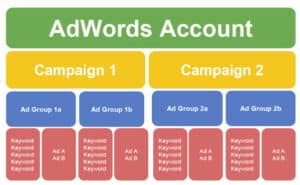How Competitors Use PPC to Steal Your Customers
If competing businesses use pay-per-click (PPC) advertising better than you, they steal customers right out from under you.
That’s not cool. Don’t they know stealing is wrong?
Fight fire with fire and learn how to take your PPC customers back with these 10 steps.
*You probably want to read this. One of our clients just doubled its PPC clicks without spending a single extra dollar. Double the website traffic with no more investment. That's serious stuff.
What is this PPC stuff all about?
PPC advertising is a type of internet marketing where advertisers (like you) pay a fee every time a potential customer clicks an ad.
You essentially pay for the best positions in the results on a search engine of your choosing. Google, obviously.
It looks like this

The Ads are clearly in a great position at the top of search results.
Why pay for ads at the top of search results when you can use search engine optimization strategies to get on the first page of Google?
Why did the Lakers need Kobe and Shaq? Why bake a pie that’s sweet and savoury? Why teach your kids to read and write?
Some things work together to multiply overall goodness.
PPC and SEO are like a reeeaaaaaal good apple pie.
Plus, the cost of a click might be $2.10, and you might land business worth $20,000 from that click. For most businesses, investing in clicks is smart.
There’s plenty to learn about SEO over here, and everything you need to know about launching a parallel PPC campaign below.
Hint: Google AdWords is the most popular PPC advertising system. Your ads appear on all Google’s digital properties, like Google search, YouTube, Blogger and more. Generally, when talking about PPC, we talk about PPC on the Google AdWords network.
10 Steps To Build The Best PPC Campaign
Step 1 – Set Your Goals
What do you want your PPC campaign to achieve?
For most businesses, it’s increased sales. You spend this ad money to make more in sales.
Then get specific.
- Is your sales force hungry for names and numbers of actual people who need to buy?
- Do you have an online shopping cart that can take orders 24/7, but customers don’t know about it?
- Is your brand in need of a booster shot?
If you struggle with specifics, figure out your end goal and work backwards.
- You might need $110k in sales every week.
- That boils down to 10 sales of an average order of $10k.
- You sell at a rate of 10%, so you need 100 leads from your PPC campaign.
Bam, you have a SMART goal right there. 100 leads from your PPC campaign.
Step 2 – Figure Out Your Audience
The worst wedding speech in history involved a large group of quiet, elderly grandparents, aunts and uncles and a poorly placed F-bomb from the best man.

And who is NOT your audience?
If you don’t think about your audience, you won’t get the result you expect.
No high fives were given at that wedding.
Do you sell tools to the construction industry? Don’t use words like gnarly and pictures of the beach in your ads.
Are you a landscaper? Don’t drop F-bombs in your snow removal ads.
We develop audience personas - text documents where we record every bit of information we can find or logically infer about the audience.
- How old are they?
- Are they married?
- What level of education did they complete?
- What is their leisure time like?
- Why do they want the product or service?
- What kind of questions might they ask?
- What are the main hesitations?
- Why would they go to a competitor?
- Who are the competitors?
- What social network(s) do they use?
Step 3 – Conduct Keyword Research
The whole internet revolves around words.
If you find the right words, you find the right customers.
But how do you find those pesky words?
- Think back to your goals. Your language needs to reflect your ideal outcome (brand awareness, increased leads, etc…)
- Ask your clients about their businesses. Their pain and their success. The language they can be super useful in your own ads.
- Use the data from your client personas to fill in some gaps.
Knowing a little about your clients, their businesses and your goals, you can do some low-tech keyword planning.
- Best price new furnaces.
- High end landscaping Burlington.
- Fast locksmith service.
- New home developments.
Make the list long. People type some weird things into Google, and you want to capture all the unique keyword combinations that could lead to you.
The next step is plugging your keyword combinations into Google’s Keyword Planner. You’ll get info like:
- How often people search for it.
- An estimated cost per click.
- How competitive the phrase is.
You know all about your keywords. Now you have to set your budget.
Step 4 – Set Your Budget and Bids
We already laid this out super clearly in an infographic earlier this year.
The long and short of it:
- You already know your goals.
- You already know your budget.
You can fill in the blanks in the AdWords system.
Remember what a single click could be worth to you. If a click has the potential to score your business $20,000, you can spend a little to get there.
Step 5 – Structure Your Account
An AdWords account is a lot like The Matrix. No one can be told what the account structure is - you have to see it for yourself.
A little overkill maybe, but it's so much easier to just show you.
An orderly account is easy to manage, track, improve, etc…
Step 6 – Write Slick Ads
Writing your ads is fun. Sometimes it’s fun. We think it’s fun, anyway. Maybe you don’t. You probably don’t, do you?
Maybe you should just have us do it for you.
If you’re determined to go ahead.
- Phrase your ads to appeal to your target, not yourself.
- If you can include numbers in your headlines, do it.
- Trigger their emotions! If they’re going to miss a good deal, let them know they’re going to miss a good deal!
- Focus on the benefit to your customer. That’s the main concern.
- Use punctuation. For some reason it really works!
Step 7 – Design Awesome Landing Pages
The best part of taking a trip to Tahiti is when you arrive, walk out of the airport and you find yourself in Tahiti. It sucks when you step out of the airport eager for some beach time and find yourself in Greenland.
You want to land where you want to land.
 Yes |
 No |
When a customer clicks one of your ads, the ad needs to transport them somewhere that makes sense.
A click leads to a landing page, and that landing page must logically connect to the ad.
Don’t:
- Write an ad about a sale and direct customers to your Contact page.
- Write an ad about new furnaces and direct customers to the About Us page.
- Send customers to your home page from an ad about new products.
Do:
- Create new webpages (landing pages) for specific ads.
- Write custom content that expands on your ads.
- Use bright, clear imagery and easy forms to encourage action from customers.
Remember – the best landing pages have specific calls to action addressing specific needs.
Don’t say Contact us for more information. Do say Reach out to our team and find the best price on winter property maintenance today.
Step 8 – Use Conversion Tracking
It’s important to know where your customers came from.
It’s important to know anything and everything about your customers. Data is the new oil.
Raw data is as useless as raw oil. But refined it is ultra-valuable. It tells you what you need to do more and what you can do less.
It’s why we measure results and deliver feedback to our customers constantly.
Step 9 – Optimize!
The reason you track your clicks, conversions, etc… is so your business can.
How exactly do you optimize your PPC campaign?
Your data might show you:
- A certain ad group gets high clicks but doesn’t respond to the landing page. So you change the landing page.
- A certain ad group gets low clicks, but the landing page hooks every person who sees it. So you alter the text on your ads.
- A keyword you thought would rock does not, in fact, rock. So you kick it out and divert your resources to a better performing option.
It’s the reason Auston Matthews still goes to practice. You can always learn something and achieve better results.

Constant training and optimization for maximum goals.
Step 10 – PROFIT!
We’re not kidding, one of our clients just increased website visits by 100% by refining its PPC campaign (and not spending another dollar).
The potential for steady, manageable increases in business success is there. As is the potential for huge growth, if it’s what you want.
The question is – can you manage your PPC in-house, without the direct help of a digital marketing service like us? Sure. Many do.
BUT!
Lots of folks like yourself also change their own brakes, drywall their own basements, represent themselves in court.
Such wondrous feats of independence are possible, but are they always good ideas? It’s totally up to you. Maintaining a good PPC campaign is engaging and involved, and has the potential to earn huge returns for your business.
Download your FREE copy of 10 PPC Landing Page Tips to Accelerate Your Revenue.
